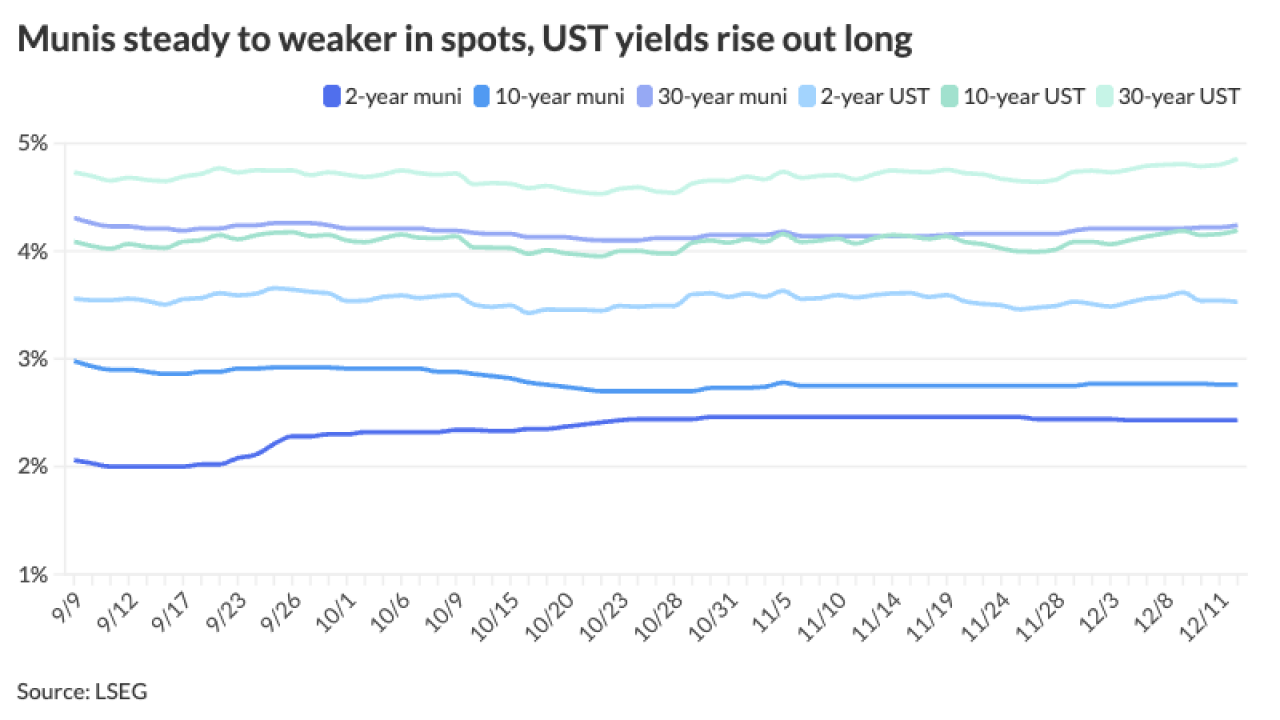
SAN FRANCISCO - The Oregon Convention Center in Portland, as well as many other development projects throughout the state, will receive funding from a $412 million lottery bond sale Oregon is planning for next week.
The deal is expected to price Jan. 8 with Citi running the books for a team of seven investment banks; it will be sold in six series of serial tax-exempt and taxable bonds.
Hawkins Delafield & Wood LLP is bond counsel.
"In general, the state uses lottery bonds to fund high priority transportation and economic development projects around the state," said Laura Lockwood-McCall, director of the debt management division at Oregon's Treasury. "Other interesting projects that this bond issue will fund include a grant of $10 million as part of a larger project to repair a defunct rail line that runs along the Oregon coast, to the Port of Coos Bay and through the Coast Range to Eugene."
The 134-mile Port of Coos Bay rail line rehabilitation is estimated to cost around $31 million. It will restore the rail line that had served as a link between inland communities and the coast for nearly 100 years before closing in 2007 due to neglect and underinvestment.
Next week's deal also funds $42 million of Connect Oregon grants, which are made on a competitive basis to both public and private entities to improve statewide multi-modal transportation connections, Lockwood-McCall said.
Other projects that will get funding include local water projects, libraries, health centers, energy efficiency programs, transit and marine navigation improvements, and affordable multi-family housing.
The Oregon Convention Center's controversial hotel project will receive $10 million of funding from the deal.
The publicly backed project faced legal challenges to construct the hotel until last month, when a judge validated the financing plan for the project. The hotel is estimated to cost $212 million, with around $60 million from issuing bonds that would be paid off with room taxes.
In total, Oregon will issue around $120 million of new money debt for these projects next week. The remaining portion of bonds is being sold to refund outstanding lottery revenue bonds.
Lockwood-McCall said the most recent numbers estimate that $269.8 million of outstanding lottery revenue bonds will be refunded, producing present value savings of $16.7 million or 6.2% of the refunded bonds.
"Ironically, we refunded about $250 million in lottery bonds in July 2014 at what seemed like terrific rates, achieving roughly $15 million in present value savings," Lockwood-McCall said. "So the continued drop in long term muni rates over the past few months was a bit of an unexpected Christmas present to the state's taxpayers."
As long as rates hold at current levels, she said it's likely the state will be refunding other general obligation and revenue bonds in January and early February 2015.
In the forthcoming deal, the new money tax-exempt bonds will have a final maturity in 2035, and the new money taxable bonds will go out to 2024. The refunding bonds will have final maturities in 2027, 2028, and 2029.
"We were the first state to issue lottery-backed revenue bonds over 30 years ago, and since we were the first to develop this type of revenue bond, we incorporated very strong credit features to entice investors, including a four-times coverage additional bonds test and a fully funded debt service reserve," Lockwood-McCall said.
The lottery bonds are secured by a first lien on the unobligated net proceeds of the state lottery.
The state also has constitutional provisions regarding the priority of payment of lottery bond debt service from net lottery proceeds.
The state has a moral obligation pledge to replenish shortfalls in the debt service reserve fund.
"Given our lottery program's long track record of sound management and operations, and these security features, it is not surprising that our lottery bonds have garnered strong ratings," Lockwood-McCall added.
Moody's Investors Service has assigned a Aa2 rating and Standard & Poor's assigned its AAA rating. Both assign stable outlooks.
The high ratings, as well as the overall lack of Oregon paper in the market, are likely to help garner strong demand from investors next week, according to market experts.
"Given the low overall level of Oregon debt [Miller Tabak Asset Management] believes this deal will do well both with in state investors and national accounts looking to diversify their portfolios," said Michael Pietronico, chief executive officer at Miller Tabak Asset Management.
His firm gives the bonds an internal A1 rating, based on the strong performance of the state lottery, but notes concerns of the discretionary nature of lottery purchase and the heavy dependence on video lottery.
Michael Ginestro, director of municipal research for Bel Air Investment Advisors LLC, also said the deal should be well-received, based on the many credit strengths it has going for it.
"When you look at this lottery bond and you compare it to other state-type miscellaneous, or pledge-tax type bonds, this really stands out as one of the stronger of many," he said. "I think this particular credit will find a home because of the broad amount of credit strengths it provides."
He pointed to the state's strong additional bonds coverage test, its quarterly revenue forecast as part of the budget process, and the well-protected debt service payments.
Standard & Poor's analysts said they assign the bonds their highest rating because of the strong debt service coverage, a robust lottery revenue tracking framework, active management, and strong bond protections.
"We don't anticipate that credit quality will come under negative pressure during the two-year outlook horizon," analysts said. "However, if negative pressure on the rating were to occur, we expect that it would involve a rapid deterioration in economic conditions resulting in a sharp pullback in consumer spending on the lottery program's gaming opportunities."
Moody's assigned a rating two notches lower, citing similar credit strengths. However, analysts pointed out that lottery sales are dependent upon game diversity and that a possible Native American gambling growth or expansion of neighbor Washington's state lottery could increase competitive pressures.
Analysts also noted the inherent volatility in the lottery's performance, given the consumer based nature of pledged revenues.
"However, we expect any declines in revenues to be mitigated by proactive management, statutory and constitutional protections limiting future competition, limits on in-state competition, minimal cross-border competition, and the state's inherent interest in the continued profitability of the operation," Moody's said.
Oregon last sold lottery bonds on July 17 in a $214 million offering in three series.
Yields ranged from 0.14% with a 5% coupon in 2015 to 2.8% with a 5% coupon in 2027.
Lockwood-McCall said she's hoping for strong demand for next week's deal.
"There has been somewhat of a dearth of new Oregon paper in the market over the past several months, so we are hoping this bond issue appeals to both retail and institutional investors who are looking for a quality credit to add to their portfolios," she said.





